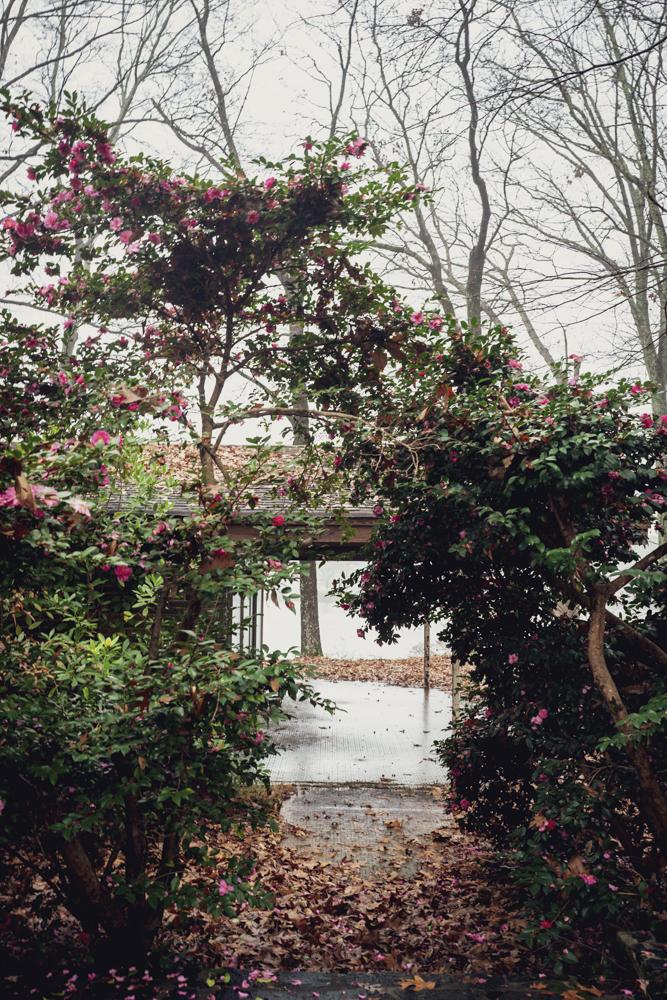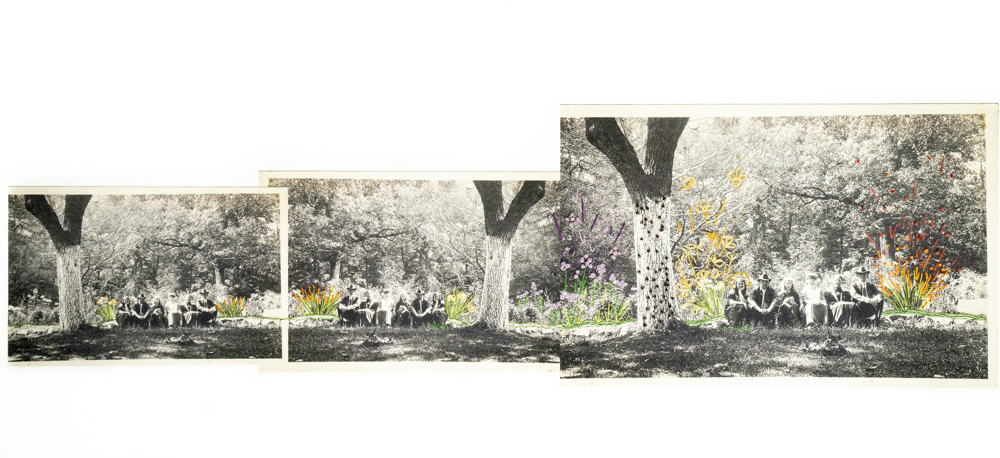Nancy Richards Farese : Add/Mix/Fold
Nancy Richards Farese has spent much of her photographic journey in the documentary realm, focusing on the critical and important issues of others. For her newest project, Add/Mix/Fold, she turns the camera inward, examining her own growing up in the South and all the ramifications of being a young woman in the 1960’s, when change was in the air. Farese has created a new family album of sorts, using interventions of thread, collage, and ephemera to expand and repair her histories and sense of self, re-contextualizing a life shaped by Southern culture and deep cultural changes were altering the role of women in American society.
Farese opens the exhibition, Potential Space: A Serious Look at Childs Play at Carrollton Center for the Arts, Roush Gallery, Carrollton, Georgia, running from August 31 – October 16, 2023.
A short interview follows.
ADD|MIX|FOLD
Add/Mix/ Fold is a visual memoir using photography, collage, and thread to explore the assumptions of growing up in the South in the Sixties. I am developing several themes that to this day I confront only obliquely: a tie to place; the moral burden of segregation; the models I had for womanhood. In complicating these photographs with thread- some mine, some ‘found’ – they become art objects offering a perspective on the contradictions of a turbulent time and the ambiguity of a “happy childhood.” As we sift through the legacy that we inherit we each must consider, what shapes us? what do we let go of? what needs repair?
This work is tactile by design, one-of-a-kind pieces that push back on digital and synthetic imagery, meant as intentional works of handcraft and documentation. By adding dimensionality with collage and thread, they suggest both assembly and exclusion. Stitching is, after all, our most ancient form of repair, associated with the practical, but also the creative, and the subversive. In bringing the past into the present, this work asks that art become an essential tool in the never-ending process of making and remaking sense of our lives, now.
Nancy Richards Farese is a California-based photographer, writer and social entrepreneur whose creative process is grounded in visual storytelling and social impact. She is an award-winning documentary photographer and has written extensively on the value of creativity and play in our work. She has collaborated with international development organizations including the UN High Commission on Refugees, Refuge Point and CARE USA to create a visual survey of children’s play around the world. The book, Potential Space; A Serious Look at Child’s Play was published in Dec, 2021. She is founder and board chair of CatchLight.io, a visual-first media organization that leverages the power of visual storytelling to inform, connect and transform communities. She lectures on the social value of promoting a more playful world, and the importance of supporting a robust visual media ecosystem in civil society. In 2023 Farese graduated with a Master’s of Fine Arts degree from Maine Media College and is presenting her thesis work, ADD|MIX|FOLD in a traveling exhibition in the Southeast. This work is about memory and the stories we tell ourselves. Farese uses photography, collage, and thread to create a visual memoir of growing up in the South in the 60s, re-examining the culture and assumptions of segregation, female identity, and place from her childhood in Georgia.
Follow on Instagram: @nancyfarese
Tell us about your childhood and your years prior to photography.
I am from a big family and a small town in Georgia. I moved to California with a big family of my own, working in banking and finance, then at home raising small kids. I began photographing locally, then, beginning in 2007, internationally for social development organizations like CARE International, the International Rescue Committee, and the United Nations High Commission on Refugees. I loved the ‘social documentary’ work, and traveled frequently with NGOs to refugee camps and disaster areas to document the human response as people surveyed their loss. It has been an amazing privilege, allowing me access to a place “I otherwise don’t belong,” as Susan Meiselas said. I was seeing an extraordinary synthesis of human response in these trauma centers – at the institutional level the UN is organizing relief that no one else can or will provide, and at the personal level staff members leave their families for months at a time to live in the desert and provide a basic safety net for people in extreme need. The world is a better place because of these agencies.
Two areas of interest developed for me out of this focus. First, I became very interested in children’s play. While I saw firsthand the most violent tendencies of humankind, I also witnessed endless displays of perseverance as kids were sliding down a mud hill or creating a game throwing shoes at a distant rock. On the edge of every frame, I saw children turning naturally to play as a way to adapt to change and heal from trauma. I immediately thought that there was something for adults to learn from this example. I have spent the last 15 years photographing this subject in 16 countries, and I have researched the power of play in healing, the impact of technology and consumerism on what used to be a simple activity, and the implications of the decline of free play on our social and emotional selves.
I published the photography book Potential Space; A Serious Look at Child’s Play in 2021. I wanted to acknowledge the common misconception that play is unimportant. In fact, nothing lights up the brain like play and it is our most essential tool for adaptation and survival. This work explores what happens when we pay close attention to what children can teach adults about play as a tool to reduce stress, connect us to each other, and have more fun in our lives. My goal is to remind us that play is essential to our well being, and to promote more play in our adult lives. Perhaps there has never been a more salient time to remember that we’ve known how to do this all along.
Second, from my early inspiration at Kakuma Refugee Camp in Kenya in 2009, I decided to start a prize, the PhotoPhilanthropy Activist Award, to reward excellence in photography done on behalf of a development organization anywhere in the world. The organization, PhotoPhilanthropy, directed philanthropy dollars to recognize photographers from as many as 61 different countries. The idea was to amplify high quality social documentary imagery that also referenced an agency working to address the social need.
PhotoPhilanthropy evolved into CatchLight in 2015, launching first with a Global Fellowship. Since 2018, under the leadership of Elodie Mailliet Storm, CatchLight has transformed our model from amplifying the work of the individual artists to impacting the entire visual ecosystem. Our mission is to leverage visuals to inform, connect and transform communities. We believe that visual storytelling is our most accessible and universal language, and a powerful force for empathy and understanding. As traditional business models for visual journalism have gone away, we are promoting new models for how that industry can function with CatchLight Local, a Visual Desk supporting local news making; we identify the best of the best in artist leaders with the CatchLight Global Fellowship; and we create community engagement to drive discussion about the ethics and impact of where photography is going. We believe there has never been a more important moment to be together and discussing the impact on our lives of new photography.
Your new project, Add/Mix/Fold is vastly different in approach and is a personal exploration. How did this change in working come about?
Now, I am doing something new. I’ve just received my MFA at Maine Media College where I had time to synthesize where I was coming from artistically with where the world was taking us, politically and socially. I wanted a structured environment to let me play more in my work. During COVID I found myself looking for ways to hold onto and process a chaotic and ephemeral present, so I looked for reference to the previous ‘most chaotic era’, the 1960s when I was a child. I became very interested in the complicated mix of fact and fiction that quilts together to form our memories, and then stories, embellished, polished, that we tell ourselves. I began sewing, beading, and collaging on images to create pieces that were both tangible and handmade. I have ‘complicated’ the image to tell a complicated story about growing up in the South in the Sixties. ADD|MIX|FOLD comes from a family pound cake recipe, a metaphor for how we mix and fold stories into memory to make sense of our present lives. I’ve come to think I should add SIFT to this title, because Southerners sift through the legacy we’ve inherited to decide what pieces to hold on to, and let go. I believe that art can give us language to express what we can’t quite say to each other.
These stories belong not only to me but to my generation of white children raised to see the world in a particular way. My approach is to present a ‘visual memoir’ allowing me a personal point of view; this work is not about improving other people as much as creating a valid expression of my own experience.
What’s next for you?
A friend told me recently ‘the opportunity in the coming synthetic world of AI is to be undeniably human’, and that’s what I intend to do with my work. I want to photograph in Georgia this summer to focus on abstraction and documentation, two ends of the spectrum that interest me. I want to print more images on fabric and wear them, as I did with my Instagram feed in 2020 and 2021, which now are on my favorite jeans — tangible, something to talk about, something to hold on to. I want to work with CatchLight to gather us, live and full of ideas, to share images and discuss where the industry is going. I want to promote both exhibitions, Potential Space and ADD|MIX|FOLD, so that I can talk with people about the essential themes of play and memory, and how they live on in our lives.
Posts on Lenscratch may not be reproduced without the permission of the Lenscratch staff and the photographer.
Recommended
-
Ricardo Miguel Hernández: When the memory turns to dust and Beyond PainNovember 28th, 2025
-
Pamela Landau Connolly: Columbus DriveNovember 26th, 2025
-
KELIY ANDERSON-STALEY: Wilderness No longer at the Edge of ThingsNovember 19th, 2025
-
Jackie Mulder: Thought TrailsNovember 18th, 2025
-
Accidental Evidence: Mike Mandel and Chantal ZakariOctober 22nd, 2025





























































